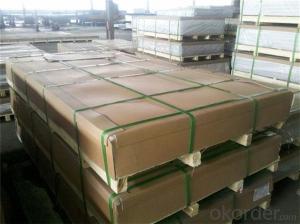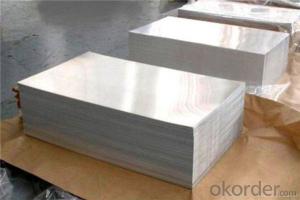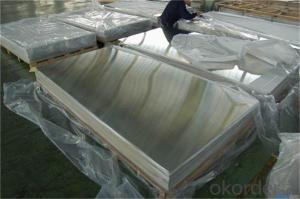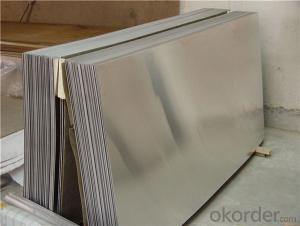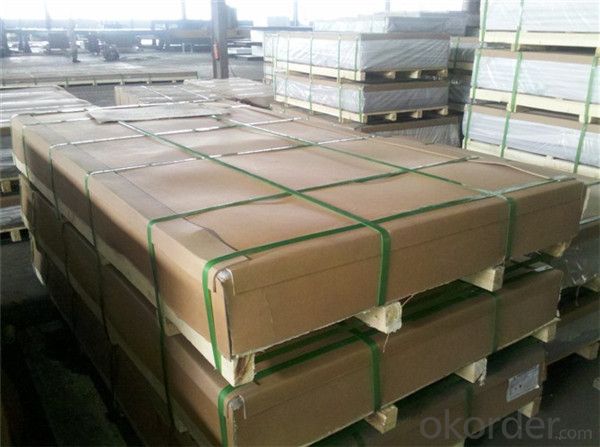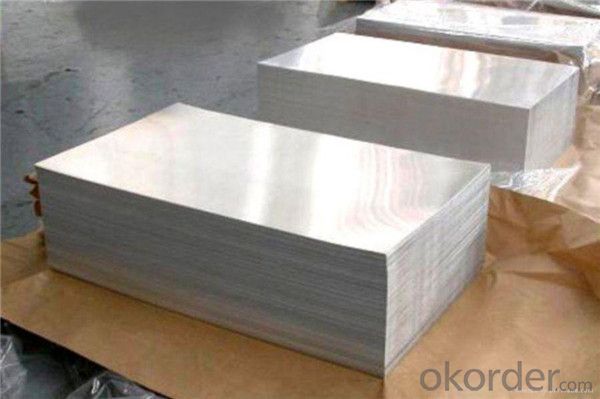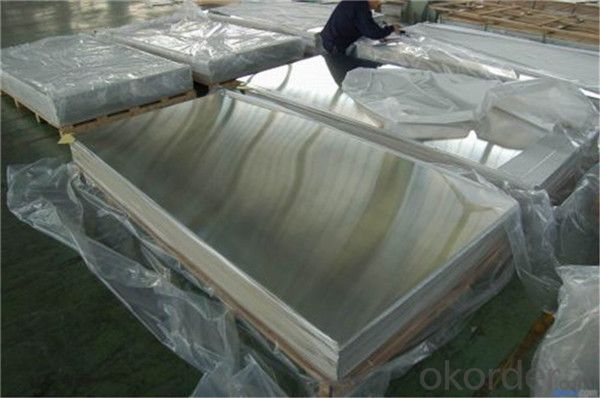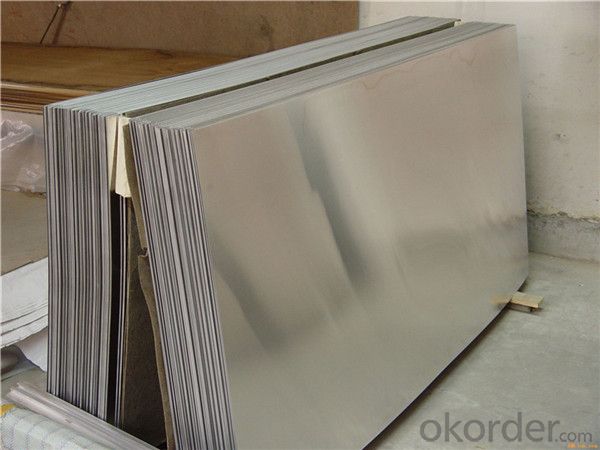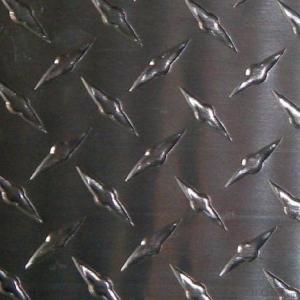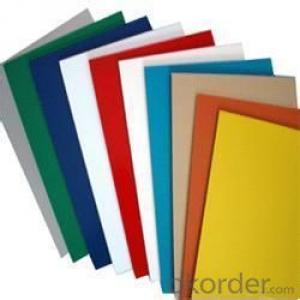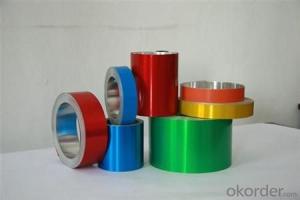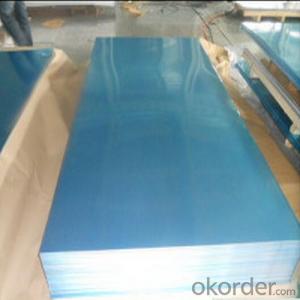Flat Aluminum Sheets for Sale - Different Thickness and Temper Color Coated
- Loading Port:
- Shanghai
- Payment Terms:
- TT OR LC
- Min Order Qty:
- 5 m.t.
- Supply Capability:
- 100000 m.t./month
OKorder Service Pledge
OKorder Financial Service
You Might Also Like
Specification
Specifications
Grade
| 1000 Series: 1050 1060 1070 1100 1200 1235 etc. 3000 Series: 3003 3004 3005 3104 3105 3A21 etc. 5000 Series: 5005 5052 5083 5086 5154 5182 5251 5754 etc. 6000 Series: 6061 6063 6082 6A02 etc. 8000 Series: 8006 8011 8079 etc. |
Thickness | 0.2~320mm |
Width | <2800mm< span=""> |
Color | Metallic, Solid, RAL or by customer requirements |
Coating paint: | PVDF(Polyvinylidene Fluoride), PE(Polyester ) |
Coating thickness | as per customer’s request |
Gloss | 10-90%(EN ISO-2813:1994) |
Total coating thick | Polyester18~27micron(EN ISO-2360:1995) PVDF27 ~35micron(EN ISO-2360:1995) |
Coating hardness | 2H |
Protective film | PVC film, Colorless transparent or White-black |
Adhesion | 5B (EN ISO-2409:1994) |
Impact resistance | No cracking and peeling (A.S.T.M D2794-1993) |
Flexibility (T-bend) | 0T- 2T |
Temper | H16, H18, H24, H26, H26 |
Certification | ISO9001:2000, CE, SGS |
Payment | L/C ,T/T |
Brief Introduction for Cold Rolled Steel Coil
Cold Rolled Steel Coil is steel that has been worked below its recrystallization temperature by passing it between a pair of rollers. Recrystallization temperature is the temperature at which grains in the lattice structure of the metal have been rearranged, leaving it free of strain and deformations. Cold Rolled Steel Coil is pre-treated before being cold rolled with a process known as pickling, which uses strong acids to remove scale and other impurities. The Cold Rolled Steel Coil is then passed through rollers to reduce its thickness. Most cold rolling takes place in multiple passes and as the size of the Cold Rolled Steel Coil is further reduced, its strength and hardness both increase, but its ductility decreases. After cold rolling, heating the metal up in a process known as annealing can restore some of its ductility. The final Cold Rolled Steel Coil may be manufactured in the form of sheets, strips, bars, or other forms.
FAQ
1. How can I get some samples?
We are honored to offer you samples. New clients are expected to pay for the courier cost. The samples are free for you.
2 Do you have any certificates?
Our products passed inspection of SGS, FDA, and CE Quality is priority! Every worker keeps the QC from the very beginning to the very end, Quality control department especially responsible for quality checking in each process.
3 Can your factory print or emboss my logo on the goods?
Yes, we can print or emboss the logo on the goods or their packing box.
4 What information should I let you know if I want to get a quotation?
1) The specification of products (length x width x thickness);
2) The temper and alloy.
3) The final product you will use to be made
4 It will be better if you can show us the pictures or design sketch. Samples will be best for clarifying. If not, we will recommend relevant products with details for reference.We usually produce goods based on customers
Samples or based on customers’ picture, logo, sizes etc.
Our Services
1. Reasonable production arrangement to make delivery very fast;
2. We are able to provide leading tolerances, metallurgical assistance, quick and reliable delivery, samples for new products, etc.
3. We have the strong capability to meet your particular requirement for the products.
4.To guarantee the quality of the products we can meet most of the standards all over the world.
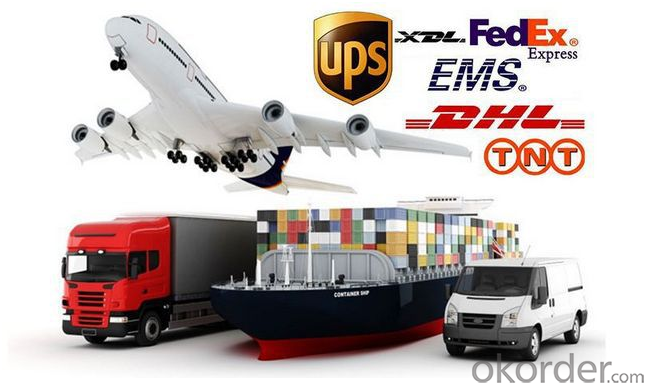
Photos of products

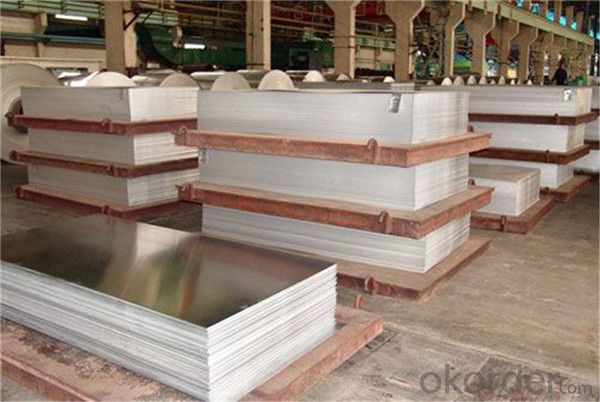
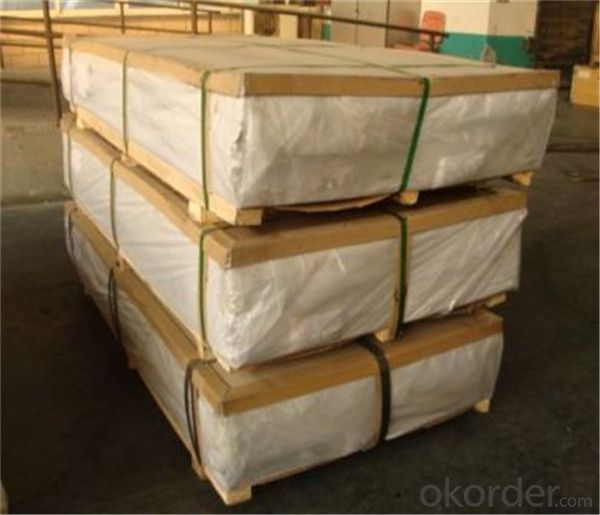
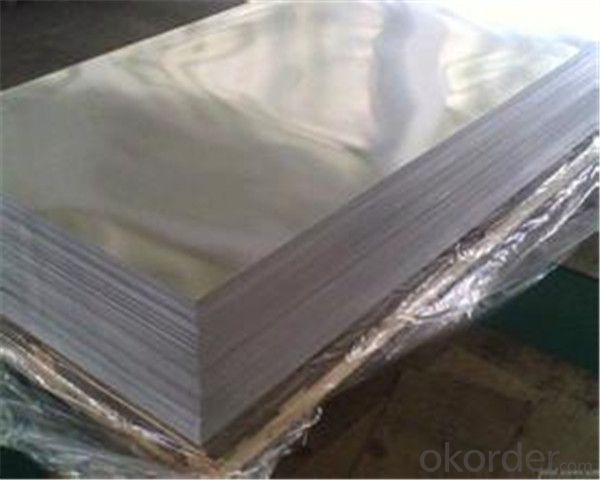
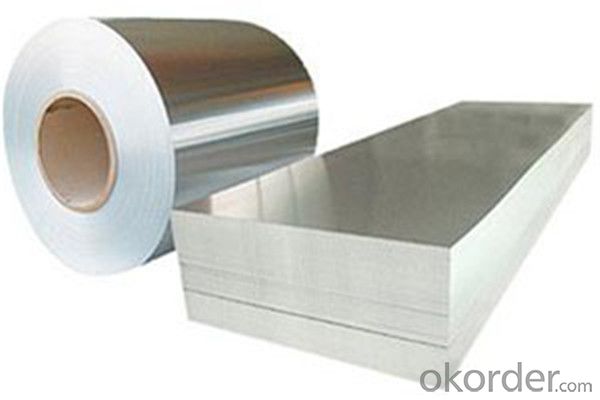
- Q: Are aluminum sheets suitable for aerospace engine components?
- Aerospace engine components can indeed be made from aluminum sheets. Aluminum is widely employed in the aerospace industry because of its advantageous properties. Its lightweight nature is crucial for aircraft and spacecraft applications, as it aids in reducing overall weight and fuel consumption. Furthermore, aluminum possesses outstanding thermal conductivity, enabling efficient heat dissipation generated by the engine. This characteristic is essential for maintaining optimal operating temperatures. Additionally, aluminum exhibits a commendable strength-to-weight ratio, corrosion resistance, and ease of fabrication. These qualities make it suitable for various engine components like casings, housings, and structural elements. Nevertheless, it is important to note that not all engine components can be solely constructed using aluminum sheets. Certain parts may require higher strength materials or specific alloys to withstand extreme temperatures or stresses. Overall, aluminum sheets have proven to be a reliable and frequently employed material for aerospace engine components. They significantly contribute to the overall performance and efficiency of aerospace engines.
- Q: Can I bake falafel patties in the oven using an aluminum foil on top of the pan I am using to put in the oven? Will the aluminum foil catch fire in the oven? Also, if I put the aluminum foil I wouldn't have to grease up the foil with oil...the patties just wont stick to aluminum foil right?
- you know what can extremely keep a cupcake from sticking, grease the muffin pan with butter. it really is what I did once after I made boxed banana nut cakes. Oh guy, i extremely omit the days even as i could prepare dinner genuine food.
- Q: How does the reflective film stick to the aluminum plate?
- Put the plate clean, dry, reflective film a head from the aluminum back 2CM at the beginning attached to the aluminum plate, wrapping, pull to the front, back and side brush paper hanging tear reflective film side with the hanging brush to the aluminum paste, try to avoid bubbles.
- Q: What is the coefficient of thermal expansion of aluminum sheets?
- The coefficient of thermal expansion of aluminum sheets differs based on the specific alloy employed. On average, aluminum exhibits a coefficient of thermal expansion of around 22 x 10^-6 per degree Celsius (22 x 10^-6/°C). Consequently, with each degree rise in temperature, the aluminum sheet will expand by 22 x 10^-6 times its original size. It should be emphasized that this figure might vary slightly among diverse grades and alloys of aluminum.
- Q: What are the different methods of joining aluminum sheets without welding?
- There are several methods of joining aluminum sheets without welding. 1. Adhesive bonding: This method involves using an adhesive to bond two aluminum sheets together. The adhesive creates a strong and durable bond, and it can be applied in various ways such as tapes, liquid adhesives, or films. Adhesive bonding is a popular choice as it provides a clean and aesthetically pleasing finish. 2. Mechanical fastening: This method involves using mechanical fasteners such as screws, rivets, or bolts to join aluminum sheets together. These fasteners provide a strong and reliable connection and are commonly used in industries where disassembly or repair is required. Mechanical fastening is also relatively easy to implement and does not require any additional equipment. 3. Clinching: Clinching is a cold-forming process that involves joining aluminum sheets by using a punch and die to create a strong interlock between them. This method is suitable for thin aluminum sheets and offers good mechanical strength. Clinching is a cost-effective alternative to welding, as it does not require any additional materials or heat. 4. Friction stir welding: Although not technically welding, friction stir welding is a solid-state joining process that uses a rotating tool to generate frictional heat between the aluminum sheets. As the tool moves along the joint, it creates a plasticized region that is then consolidated to form a strong bond. Friction stir welding is mainly used for joining thicker aluminum sheets and offers excellent mechanical properties. 5. Folded joints: This method involves folding the edges of two aluminum sheets together to create a joint. The folded joint can be secured by using adhesives, mechanical fasteners, or a combination of both. Folded joints provide good strength and stiffness, and they are commonly used in applications where a seamless appearance is desired. These methods offer various advantages and can be chosen based on the specific requirements of the project, including the desired strength, appearance, and ease of implementation.
- Q: Can 101 aluminum sheets be stamped or engraved?
- Certainly! Stamping or engraving 101 aluminum sheets is indeed possible. Aluminum, being a highly adaptable material, lends itself well to different manipulation techniques. Stamping entails exerting pressure to imprint a design or pattern onto the aluminum sheet, whereas engraving involves carving or incising a design onto it. Both methods can be applied to aluminum sheets, including those composed of 101 aluminum alloy. Nevertheless, it is crucial to take into account the thickness and hardness of the sheets, as these variables might impact the precision and sharpness of the stamped or engraved design.
- Q: This question asks for an explanation of the various grades of aluminum sheets and the distinctions between them.
- <p>Aluminum sheets are categorized into different grades based on their alloy composition, which affects their properties such as strength, formability, and corrosion resistance. Common grades include 1000 series (99.00% aluminum, soft and malleable), 2000 series (aluminum-copper alloys, strong and heat treatable), 3000 series (aluminum-manganese alloys, good formability), 5000 series (aluminum-magnesium alloys, good strength and corrosion resistance), and 6000 series (aluminum-silicone-magnesium alloys, good strength and extrudability). Each grade has specific applications based on its characteristics, with 1000 series used for general purposes, 2000 series for aircraft structures, 3000 series for decorative applications, 5000 series for marine environments, and 6000 series for structural components.</p>
- Q: I need to make an aluminum cylinder out of 1/8 6061 plate and tube. I don't have a TIG setup and was considering using Bernzomatic aluminum soldering rods. The cylinder will be pressurized from 20-60 psi. Assuming a clean job, is this pressure ok? How much pressure can the joint take? Also, although the solder does not need flux, should i use it anyway?
- Whether that weld will be OK depends on the diameter of the cylinder. The force on the weld will be equal to the operating pressure time the radius of the cylinder, with the wall opposite the weld have an equal force. Divide that force by the thickness of the weld to figure the stress. You want to have a safety factor of about 3. As the Bernzomatic has either a brass or aluminum head, which would melt at the temperatures which are required for true welding (melting metals so that they flow together), you will be performing brazing with a Bernzomatic. I cannot comment on the strength of the brazing bond. The thickness of the brazing metal deposit depends on the strength of the brazing alloy, which I also cannot comment on. 6061 will melt at 1206°, which you will not approach with the Bernzo kit. A blowout of a metal cylinder at 60 psi could be pretty ugly. I suggest that you befriend someone who has a TIG welder and get their help. A properly welded 1/8 thick cylinder could handle about 660 psi with no problem. If you create a lap joint, using an outer strip of aluminum, and then band your cylinder with stainless steel hose clamps, you will be relying upon the brazing only to provide a gas seal. The strength would come from the hose clamps. You still need to do some calculation on forces involved. A 1/2 wide stainless hose clamp will probably hold back about 240 lb. of force with a comfortable margin of safety.
- Q: What are the different grades of aluminum sheets?
- In the market, a variety of aluminum sheet grades can be found, each having its own unique properties and uses. Some commonly used grades are 3003, 5052, and 6061. Grade 3003, a non-heat treatable alloy, displays high resistance against corrosion. It finds its application in scenarios where corrosion resistance is crucial, such as packaging, cooking utensils, and chemical equipment. Grade 5052, also non-heat treatable, offers exceptional corrosion resistance along with strength and durability. This makes it suitable for marine applications, transportation equipment, and architectural purposes. Grade 6061, a heat treatable alloy, combines good corrosion resistance with high strength. It is extensively used in structural applications like aircraft components, automotive parts, and construction materials. In addition to these grades, there are specialized aluminum alloys like 2024, 7075, and 5083, catering to specific properties required in particular industries or applications. To ensure the right grade of aluminum sheet for your project, it is crucial to consider its specific requirements, as each grade possesses its own strengths and limitations. Seeking advice from a knowledgeable supplier or expert can assist in determining the most suitable grade for your needs.
- Q: Are 101 aluminum sheets resistant to UV radiation?
- Generally speaking, 101 aluminum sheets exhibit resistance to UV radiation. This is due to the formation of a natural thin oxide layer on the surface of aluminum, which serves as a protective shield against UV rays. Consequently, the aluminum is safeguarded from deterioration or degradation when exposed to sunlight. Nevertheless, it is worth noting that prolonged exposure to intense UV radiation can still result in gradual discoloration or fading. Therefore, in situations where the aluminum sheets will be continuously exposed to direct sunlight for long durations, it is recommended to consider applying a protective coating or utilizing a specialized UV-resistant paint. These measures will further enhance the aluminum sheets' ability to withstand UV radiation.
Send your message to us
Flat Aluminum Sheets for Sale - Different Thickness and Temper Color Coated
- Loading Port:
- Shanghai
- Payment Terms:
- TT OR LC
- Min Order Qty:
- 5 m.t.
- Supply Capability:
- 100000 m.t./month
OKorder Service Pledge
OKorder Financial Service
Similar products
Hot products
Hot Searches
Related keywords
